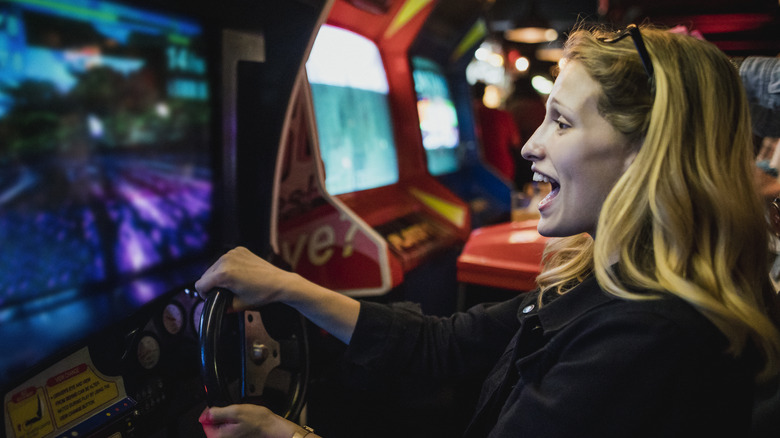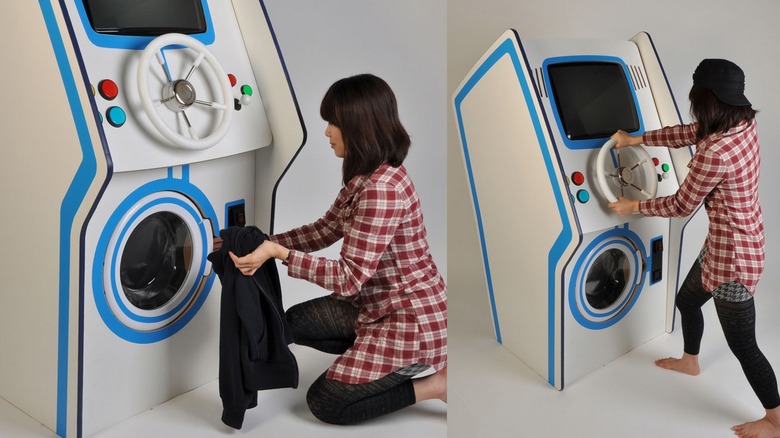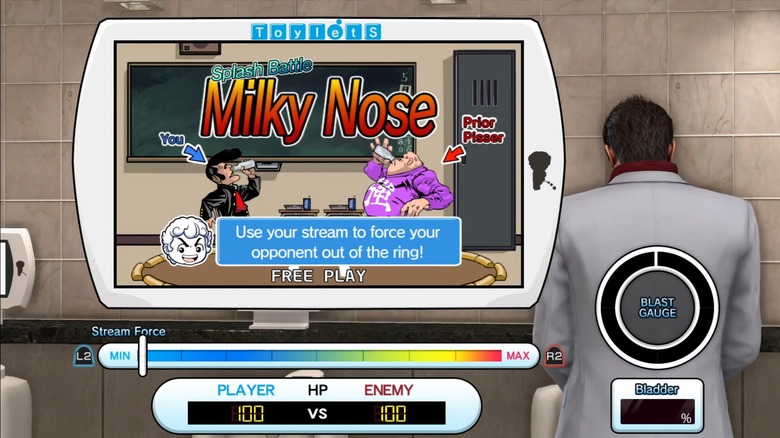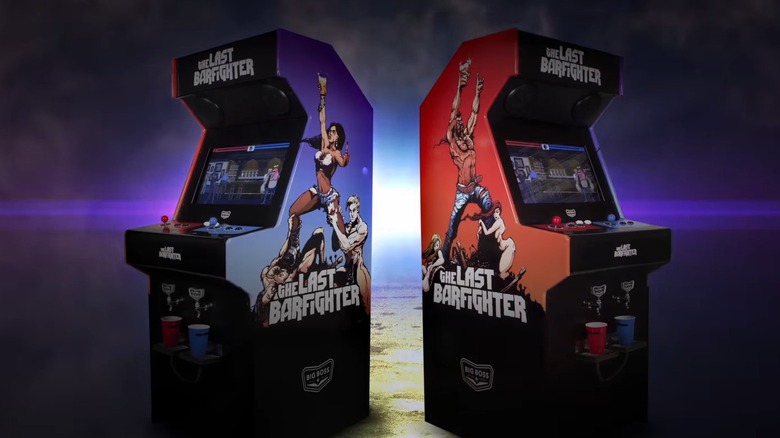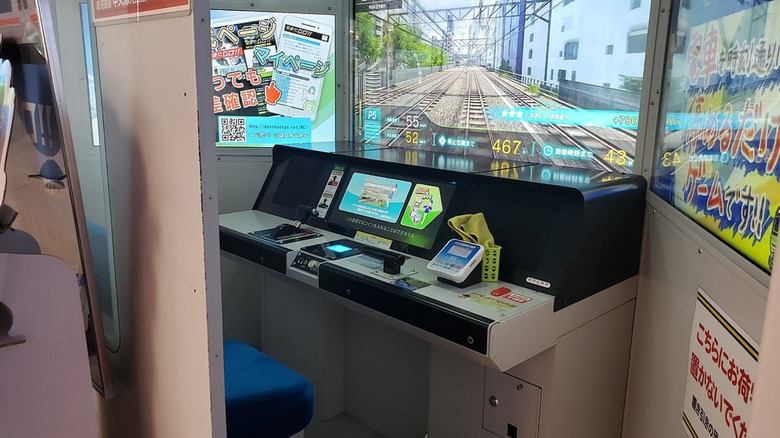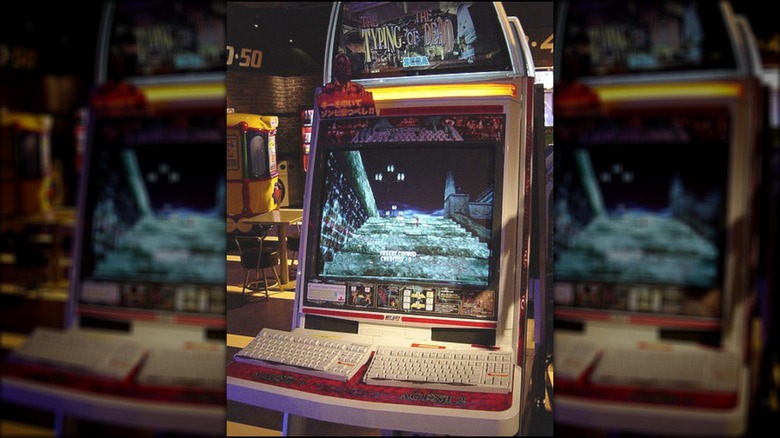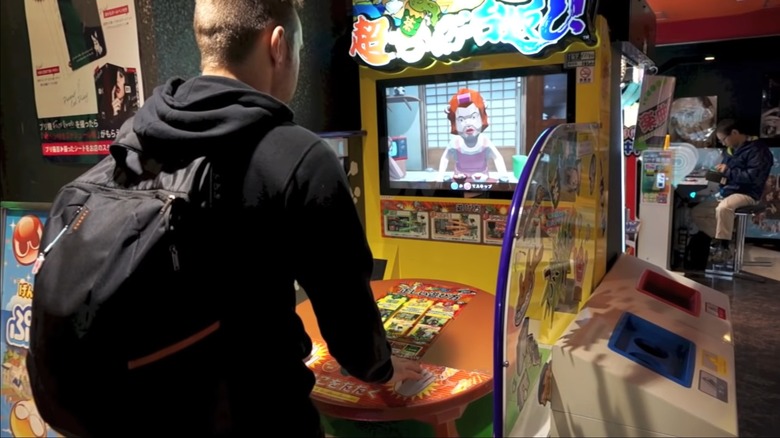7 Of The Strangest And Most Unorthodox Arcade Cabinets Ever Made
Video game controls and controllers have become fairly homogenized. Want to jump in a platformer? Press the button at the bottom-right corner of your controller. Want to use a gun in a first or third-person shooter? Press the left trigger button to aim and the right trigger to fire. Similar rules apply to arcade machines, but not always.
Like console games, arcade cabinets tackle a variety of genres, but unlike their console counterparts (and in some cases ports) designers don't have to model control schemes around unified controller designs. Fighting games and beat 'em ups like "Tekken" and "The Simpsons Arcade Game" use large joysticks and buttons; classic racing games like "Daytona USA" and "Out Run" generally rely on steering wheels and fake gas pedals, and shooters like "Time Crisis" and "Halo: Fireteam Raven" encourage pointing plastic guns at screens. These are the most common control schemes, but developers are under no obligation to follow them. In fact, studios can let their freak flags fly and invent whole new genres with novel control schemes and gimmicks. Many of the most iconic vintage arcade machines have unique control schemes and designs.
Here are some of the strangest and, quite frankly, most ridiculous arcade games ever devised by the human mind. Yes, even stranger than that game that gives you tickets for milking a plastic cow. Seriously.
*Note*: Many games listed in this article are from East Asian countries including Japan, and in some cases were designed with East Asian tropes, sensibilities, and styles of humor in mind.
Amusement Washing Machine
The definition of "arcade game" is flexible. While the term usually describes video games that accept quarters and are housed in cabinets, it can also apply to short games that vend various prizes or tickets, based on luck or ability. It turns out, it can also cover gadgets that wash your clothes.
In 2011, engineering student Lee Wei Chen unveiled the "Amusement Washing Machine." As its name suggests, this machine was one half arcade cabinet, one half washing machine. You just loaded your laundry into the bottom, inserted coins, selected the wash and game difficulty, and then the fun began. Or the pain, depending on your reaction time.
The Amusement Washing Machine provided several minigames using the giant wheel in the front, while you waited for your laundry to finish — at first, anyway. In reality, the Amusement Washing Machine demanded your full attention. As soon as you lost all of your lives, the wash cycle would stop, forcing you to either remove wet clothes dripping with soap or insert more coins and try again. Thankfully, it wouldn't force you to start over from the beginning, but your skills determined whether you washed your clothes at a discount or blew all your change on one load.
Chen invented the Amusement Washing Machine so the average person (i.e., those without Twitch streams) could put their video game skills to good use. The designer also hoped it would help him land a design job. Still, don't expect the Amusement Washing Machine to grace your local laundromat or Dave & Busters anytime soon.
Sega Toylets
The "Yakuza" franchise is known for three things: terrific combat, dramatic storylines and characters, and the most bonkers side activities and missions this side of "Saints Row 2." The "Yakuza" games are also filled to the brim with classic Sega arcade games, and you can usually tell the difference between the ports and the novel additions. Usually.
In 2011, Sega started distributing a series of urinals branded as Sega Toylets (intentionally misspelled with a "y" instead of an "i"). Each gamified latrine was attached to an LCD screen that let users pick from several minigames, but instead of people merely playing games to bide their time, Toylets turned the mere act of urination into a game itself. Men sometimes refer to their urinary equipment as joysticks, but who could have ever guessed Sega would take that slang literally?
Toylets were outfitted with pressure sensors that detected where urine landed and how hard, and its games rated users on their aim and stream strength. And people weren't just handed seemingly arbitrary high scores. For instance, the minigame — released in Japan as "Battle! Milk from the Nose" and internationally as "Milk Jet Battle" — compared the strength of users' streams in competitions that translated their respective powers into cartoonish blasts of nostril-propelled milk.
Sega discontinued the Sega Toylet in 2016, but its minigames live on in restrooms peppered throughout the fictional district of Kamurocho in "Yakuza Kiwami 2."
Beercade: The Last Barfighter
Have you ever heard of a Barcade? If you visit one, you get to play classic cabinets like "Gauntlet" and "Star Trek: The Next Generation Pinball" while enjoying all manner of alcoholic drinks, including craft beers. But have you ever played an arcade machine that vends craft beer?
At first glance, "Beercade: The Last Barfighter" was a simple title. The game was a fighter where players used standard fight sticks and buttons to control one of five characters – a pathetically small roster almost to the point of being insulting. Moreover, all fights took place within a bar. Where was the variety and personality that set the game apart from rival fighting cabinets? That came later, and only if you won a match and brought a cup.
In truth, "Beercade" was never meant to be a bona fide arcade game. Instead, it was the brainchild of the ad agency McKinney to advertise Big Boss Brewing Company, which is why winners received a cup of beer to celebrate their victories. You didn't even need to insert any coins to play, but your ability to enjoy a nice cold one rested solely on your 2D fighting game skills. Unless your opponent decided to share a pint with you, that is.
If you ever find a "Beercade: The Last Barfighter" cabinet in the wild, give it a try. And if you win, use the frothy spoils to toast your hosts.
Densha De Go!
Simulation games are a dime a dozen, but how realistically do they simulate their subject matter? At the end of the day, you're still driving tractors and trucks in "Farming Simulator 22" with game controllers, which you don't normally find in modern vehicles. It's why the flight simulators pilots actually train on have replica cockpits.
The "Densha De Go!" franchise has been running reliably since 1996 for arcades, PCs, and consoles. Each entry revolves around the premise of driving a busy commuter train. It sounds simple enough, but Japan takes its trains seriously, and the same is true of Japanese train simulators. You have to stick to schedules down to the second and hit your targets within as little as a centimeter of error, using all the same tools as a real train conductor. Not so easy now, is it?
Much of the magic behind "Densha De Go!" is its unique control scheme, which mimics the speed and brake mechanisms of actual trains. You feel like you're driving a real train down Japanese railways, polygonal graphics notwithstanding. The cabinets even recreate the speedometers and flashing notification lights of a driver's compartment. While "Densha De Go!" has experienced graphical upgrades throughout the years, the controls have stayed the same. Taito even released a now-obscure control accessory mimicking the arcade controls for home releases on classic consoles like the Nintendo 64 and Sony PlayStation, as well as plug-and-play editions. If it ain't broke, don't fix it.
Given the cathartic addiction that comes from commandeering trains, it's a shame the series hasn't been localized for non-Japanese audiences.
[Featured image by HSV via Wikimedia Commons | Cropped and scaled | CC BY-SA 4.0]
The Typing of the Dead
"The House of the Dead" is among Sega's most popular arcade games. This simple yet fun zombie apocalypse lightgun franchise has come to numerous consoles, including a bundled release on the Nintendo Wii. Like other successful franchises, Sega used the "House of the Dead" brand to kickstart spin-offs, including one of the strangest arcade cabinets ever released.
"The Typing of the Dead" was a port of "The House of the Dead 2" that completely altered the experience. While the game featured the same levels and enemies, instead of killing zombies by aiming fake guns at TV screens, you killed zombies by typing out words. Forget "the pen is mightier than the sword;" in "The Typing of the Dead," the keyboard was mightier than the Beretta M9.
While "The Typing of the Dead" released stateside on the Sega Dreamcast and Windows PCs, in Japan the game initially launched as a dedicated arcade machine, like its predecessor. Each "The Typing of the Dead" cabinet featured two fully functional keyboards, specifically those designed for the Sega Dreamcast. Since "The Typing of the Dead" arcade cabinets never left Japanese shores, players could challenge their typing skills with hilarious sentences in either English letters or Japanese hiragana.
Even though "The Typing of the Dead" never reached the same level of popularity as its lightgun source material, the game received several sequels, but only "The Typing of the Dead 2" (based on "The House of the Dead 3") got the arcade cabinet treatment.
[Featured image by Chuck via Wikimedia Commons | Cropped and scaled | CC BY-SA 4.0]
Inu No Osanpo
Walking a dog can be a relaxing way to get fresh air, endorphins, and exercise, or it can be a trying time full of irritation...and exercise. It all depends on how well you can keep up with your dog and control them. Learning is a trial by fire since you can't practice in a safe, simulated environment, or can you?
In "Inu No Osanpo," you take a dog on a walk. It's not exactly new territory for video games, but "Inu No Osanpo" puts a novel spin on this otherwise normal act. At least, it's novel for people who haven't walked dogs before.
"Inu No Osanpo" is one part "joystick" (in the form of a dog leash) and one part treadmill, and you have to guide the digital dog away from danger on the screen by pulling the leash in the opposite direction. The game has several difficulty levels based on your breed of choice. The goal isn't to run as fast as you can but to keep pace with the pet. Like real dogs, these pixelated pups have minds of their own and don't like being pulled just because your speed doesn't match theirs.
While "Inu No Osanpo" doesn't compare with the joys of walking a real dog, it is still a unique concept that quite frankly needs more attention. If any treadmill manufacturers are reading this, can you create a special line of devices that task users with walking dogs at different paces? That probably would encourage more people to run on treadmills.
Cho Chabudai Gaeshi
While comedy is universal, the tropes and gags that constitute it differ from country to country. North American comedy is characterized by fast and frantic exchanges and slapstick, whereas Japanese jokes often rely on wordplay and comically over-the-top actions, such as flipping a table. In fact, this seemingly violent act has become anime shorthand for expressing anger and makes for a surprisingly cathartic arcade game.
"Cho Chabudai Gaeshi," roughly translated as "Super Table-Flip," is a game where you, well, flip a plastic table as hard as you can. First, you slam your hands on a plastic table to grab the attention of NPCs, and when that fails, it's time to heave it with all your might. While the actual table peripheral remains solidly on its hinges, the on-screen destruction can put earthquakes to shame.
Each "Cho Chabudai Gaeshi" session only lasts 60 seconds, but the payoff is still satisfying, thanks to how the game frames the resulting physics-powered destruction. According to people who have played it, "Cho Chabudai Gaeshi" is an excellent outlet for stress. Few sights are more satisfying than watching a table fly across a room, especially when you know nobody was hurt.
Because the fake table of "Cho Chabudai Gaeshi" needs to stay firmly rooted to the ground, or at least to a heavy arcade cabinet, the game has no chance of being ported to home consoles. Anyone who tries would likely be held responsible for all the real tables flying around game rooms.
